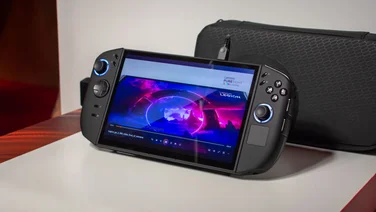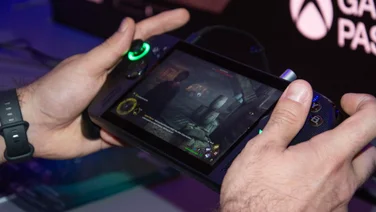To help us provide you with free impartial advice, we may earn a commission if you buy through links on our site. Learn more











It’s 1984. Three Spetsnaz commanders are conducting a secret meeting at a remote Afghan military base. It’s 1PM and the sun is blazing. I ride my trusty horse down an unguarded maintenance road, keeping out of sight until I’m right outside the base. After crawling through a drainage tunnel I emerge next to the meeting point. Three shots from a tranquilized pistol put my targets to sleep, but they are too valuable to kill. Instead, I attach a Fulton balloon to each soldier and send them floating into the sky, ready to be retrieved by my support team. I crawl back outside and ride by horse off into the sunset, undetected. Mission complete.
The Phantom Pain is a stunning example of how giving players an entirely open world can create myriad ways to approach a single objective. Hideo Kojima’s stealth series might have started life with linear, story-driven adventures, but Metal Gear Solid 5 leaves almost everything up to player choice. The order in which you tackle each mission, the equipment and weapons in your loadout, the AI-controlled buddies you bring along with you, and what time of day you make your move can all be changed on the fly, often resulting in completely different experiences each time. Enemy patrol routes change depending on the time of day, too.

It’s 1984. Three Spetsnaz commanders are conducting a secret meeting at a remote Afghan military base. It’s 3AM and clouds are blocking out the full moon. I’ve just airdropped in on the mountains above the base with my sniper companion. She quickly spots the patrols, security cameras and my targets. We eliminate with silenced rifles, then exfiltrate by foot. Mission complete.
Players are actively encouraged to mix up their strategies, as enemies quickly adapt to your methods. Helmets will be issued to soldiers if you rely overly on sniper rifles and headshots. Enemies will gradually get shields, body armour and riot gear if you only use close-quarters weaponry. Steal enemy resources without getting detected and surveillance cameras will begin appearing at outposts and military bases. Only attack at night and soldiers will soon be equipped with night vision goggles. The continual adaptation of the bad guys means you’re constantly second-guessing what opposition you’ll encounter on each new mission.
With two huge open areas, there’s massive scope for exploration, even if there’s a lot of empty space between the populated areas. The game’s Fox engine runs beautifully on PC, with stunning draw distances and incredible object detail; protagonist Big Boss’ sneaking suit creases convincingly as he runs, gets wet when it rains and gradually gets dirtier and bloodier as you spend time in the field without returning home for a shower. The attention to detail is simply staggering.
It’s 1984. Three Spetsnaz commanders are conducting a secret meeting at a remote Afghan military base. It’s 6AM and the sun is about to rise, but the outpost is already filled with armoured cars. I’ve decided against the subtle approach, ordering my helicopter pilot to hold position above the base, while I mark the targets below. Five seconds later an aerial bombardment rains down, blowing the meeting point to pieces as my helicopter flies out of the hot zone. Mission complete.
It helps that the control system is sublime, whether you’re playing on a gamepad or with a mouse and keyboard. Big Boss can sprint, climb, crawl, peek around corners and hang from ledges in an effort to remain undetected, but you’re also helped by a few seconds of slow motion when a guard does spot you. This tiny Reflex mode window gives you just enough time to score a headshot or land a quick punch combo and prevent a full alert. At the outset you’ll need to rely on close-quarters engagements, but you quickly amass a huge arsenal of gadgets and weapons which all create new gameplay possibilities.

The non-lethal approach makes a lot more sense, though, as you’re reliant on captured enemy soldiers to build up your home base and unlock new development options. It’s hilarious to attach a Fulton balloon (which floats up into the sky to be retrieved by a cargo plane) to an unsuspecting enemy (and even more so to a sheep or armoured car) but it becomes a vital way to upgrade Big Boss’s skills and inventory. You can extend your home base, adding extra platforms and decks to make room for more soldiers, and protect it with security cameras, electric fences and decoys, which are essential to keep your plundered raw materials and workers safe from other players in multiplayer mode. The multiplayer component is a brilliant addition, with the ability to invade other players’ bases in an attempt to steal resources, but doing so makes you a target for retaliation later. It’s entirely optional, too, so you can stick to offline mode if you prefer.
Of course, as a Metal Gear Solid game, fans of the series can expect a highly convoluted story filled with intrigue, double-crossing and larger-than-life characters. The plot quickly enters spoiler-territory, so it’s difficult to go into details, but it’s surprising that cut-scenes and long conversations now take a back seat compared to previous titles. Kiefer Sutherland has been brought in to voice Big Boss, replacing series veteran David Hayter, but much of his performance is hidden away in optional cassette tape briefings that can be played while you do other things.
The opening few hours will be perplexing to anyone unfamiliar with the series, but the prologue is meant to disorient even the most ardent Metal Gear fans – even those that played standalone prologue Ground Zeroes. After waking from a nine-year coma and now missing an arm, Big Boss has to escape a hospital being raided by a hostile military force. Helped by a mysterious ‘Ishmael’ and chased by a man on fire, the situation is nothing if not confusing. The plot soon settles down once you’re back at Mother Base, your offshore oil platform that acts as a staging area between missions, but quickly becomes inconsistent.

Metal Gear fans hoping that the Phantom Pain would neatly resolve what happened between the events of Peace Walker and the original MSX2 title will be severely disappointed. After a mostly coherent Chapter One, Chapter Two feels largely unfinished, as you’re forced to re-do missions on harder difficulties while the plot development occurs at seemingly random intervals. The second chapter is much shorter than the first and ends all too abruptly. It’s common knowledge that Hideo Kojima and publisher Konami have very publicly parted ways, which immediately raises questions as to whether the director was allowed to finish his vision for the game, or whether he was forced to make cuts in order to release it on time. Just like the game’s plot, there are many questions left unanswered that will keep fans guessing for a long time to come.
Despite all this, though, the Phantom Pain is an absolute joy to play. By creating the illusion of an open world, despite each mission being somewhat self-contained, and giving players the choice of how to approach each encounter, it feels more like a true stealth action game than any Metal Gear title that came before it. Whether you’re familiar with the series or not, it’s an absolute must-play.






